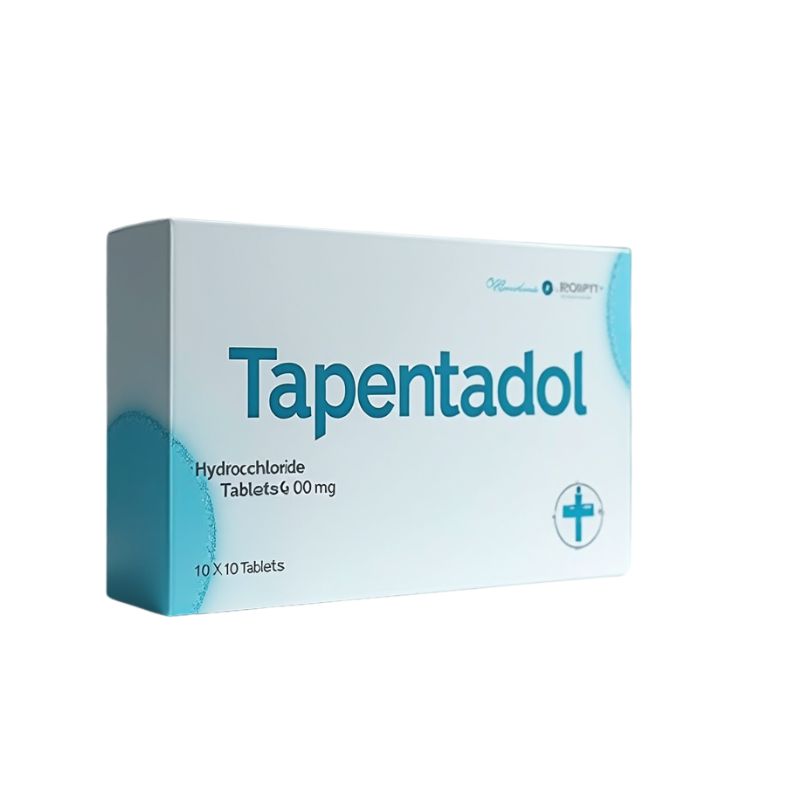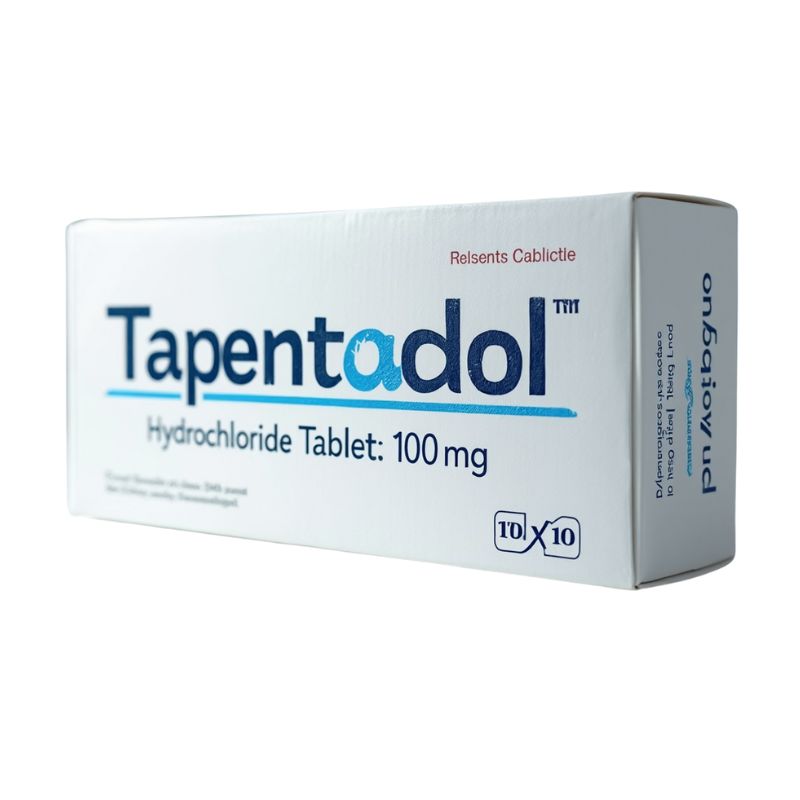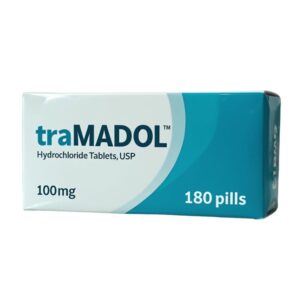Tapentadol
Generic Name: Tapentadol
Brand Names: Nucynta, Palexia (varies by region)
Drug Class: Opioid Analgesic
Schedule: Schedule II Controlled Substance (U.S.)
Prescription Required: Yes
Formulations: Immediate-release tablets, Extended-release tablets
Available Strengths:
- Immediate-release (IR): 50 mg, 75 mg, 100 mg
- Extended-release (ER): 50 mg, 100 mg, 150 mg, 200 mg, 250 mg Route of Administration: Oral
Overview
Tapentadol, an opioid painkiller, acts on the brain to alleviate moderate to severe acute and chronic pain. Tapentadol functions in two distinct ways that set it apart from other opioids. It works as both a mu-opioid receptor agonist and a norepinephrine reuptake inhibitor (NRI). This unique combination effectively alleviates pain and may have less impact on the digestive system compared to traditional opioids such as morphine or oxycodone. Tapentadol is often prescribed for pain after surgery, pain caused by injuries, diabetic peripheral neuropathy, and long-term musculoskeletal conditions like osteoarthritis or lower back pain.
Mechanism of Action
One way that tapentadol relieves pain is by doing two things:
- Antagonism of mu-opioid receptors: It connects to opioid receptors in the brain and spinal cord, which stops pain signals and eases pain.
- Blocking the reuptake of norepinephrine (NRI): Increasing the amount of norepinephrine in the synaptic cleft makes the body’s natural system for reducing pain work better, especially for neuropathic pain.
Tapentadol works for both nociceptive and neuropathic pain because of these three mechanisms. It is different from other opioids that only work for nociceptive pain.
Indications & Uses
This drug, tapentadol, is approved and prescribed to treat:
- Moderate to severe acute pain, such as after surgery or from an injury
- Musculoskeletal pain that doesn’t go away (like lower back pain or osteoarthritis)
- Pain that comes from diabetic peripheral neuropathy (ER version only)
Because it is powerful and easy to abuse, it is usually not suggested for mild or short-term pain.
Dosage and Administration
Formulation for Immediate Release (IR):
- 50 mg to 100 mg every 4 to 6 hours at first, as needed for pain
- For the IR formulation, the maximum daily dose is 600 mg.
Formulation for Extended-Release (ER):
- Start with 50 mg twice a day.
- Titration: You can adjust it by adding or removing 50 mg every three days.
- The most you can take in a day is 500 mg (250 mg twice a day).
Note: Each patient’s dose needs to be customized based on their level of pain, their history with opioids, and how they react to the medicine.
Onset and Duration
- Start of action: Between 30 and 60 minutes
- Peak plasma concentration: between 1.25 and 3 hours (IR); between 3 and 6 hours (ER)
- Effect lasts for 4 to 6 hours (IR) and up to 12 hours (ER).
Benefits of Tapentadol
- The dual mechanism gives you better pain control.
- Helpful for both short-term and long-term pain
- It helps with managing neuropathic pain.
- Less likely to cause constipation than regular opioids
- For chronic pain, it comes in an extended-release form.
- Due to its wide range of effects, it may cut down on the need for other medicines.
Side Effects
Like all opioids, tapentadol can cause several side effects, some of which are mild and others more serious. Usually, side effects depend on the dose. Common Side Effects:
- Feeling sick or vomiting
- Feeling sick
- Being sleepy
- Gas and bloating
- Headache
- Weakness
- Toothache
- Sweating
Serious Side Effects:
- Depression of the lungs
- Having seizures
- Serotonin syndrome (especially when taken with MAOIs or SSRIs)
- Low blood pressure
- Not enough adrenaline
- Dependence and signs of withdrawal
Get medical help right away if you are having trouble breathing, are confused, or aren’t responding.
Warnings and Precautions
- Chance of becoming addicted, abusing, or misusing: Abuse of Tapentadol, a Schedule II controlled substance, is highly likely, particularly with prolonged use.
- Respiratory depression that could kill you: When giving a dose, be cautious, especially to people who have never used opioids before and to older or disabled people.
- NOWS stands for neonatal opioid withdrawal syndrome. It can happen to babies whose mothers took Tapentadol for a long time while they were pregnant.
- How it interacts with CNS depressants: These include drugs like alcohol, benzodiazepines, and sedatives that can put you into a coma or even kill you.
- Risk of serotonin syndrome: Mixing serotonin-boosting drugs like SSRIs, SNRIs, and MAOIs increases the risk of serotonin syndrome.
- Problems with the liver and kidneys: Be careful around people who have liver or kidney disease. There may be a need to change the dose.
- To drive and run machines: Because tapentadol could make you sleepy or dizzy, don’t do these things until you know how it affects you.
Drug Interactions
- There are many medicines that can interact with tapentadol, such as
- Alcohol makes CNS depression worse
- MAO inhibitors shouldn’t be taken within 14 days of taking tapentadol.
- SSRIs and SNRIs raise the risk of serotonin syndrome.
- Benzodiazepines: they make you sleepier
- CYP450 inducers or inhibitors may change the amount of tapentadol in the body.
Before taking Tapentadol with other drugs, you should always talk to your doctor or pharmacist.
Tapentadol vs. Other Pain Medications
| Medication | Mechanism | Abuse Risk | Neuropathic Pain? | GI Side Effects |
| Tapentadol | Mu-opioid + NRI | High | Yes | Lower |
| Oxycodone | Mu-opioid | High | No | Moderate |
| Tramadol | Weak opioid + SNRI | Moderate | Yes | Lower |
| Morphine | Mu-opioid | High | No | High |
| Duloxetine | SNRI (non-opioid) | None | Yes | Low |
Tapentadol is better for people who have both neuropathic pain and acute or chronic nociceptive pain, and they want to keep side effects like constipation to a minimum.


